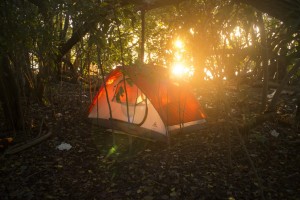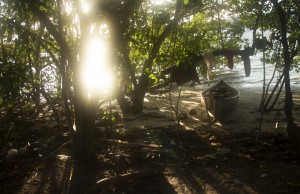On Capsizing A Canoe In Biscayne Bay
Franky Cruz
Before the boaters and the jet skiers were even up, we set off; it was so calm we almost didn’t need to paddle. The dome-shaped island was like a magnet slowly pulling us toward it. After circling the islands, we landed ashore still full from the sublime float across. We stashed our cooler, hammock, tent, and other supplies around the island, camouflaged within the surrounding terrain, no different than the other human objects that were already there. Bird Key Island was next, where the white herons can be seen flapping on the trees in the distance, even as the concrete continues to encroach on this patch of what’s left of wildlife.
With a tremendous rustle of leaves and branches, a very big adult male iguana dropped in on us from about ten feet and landed three feet away with spikes and crests in full flair, huffing and puffing, wiping its tail, challenging us in his territory. Nesting birds nesting above scared, aware of our presence, flying away, but not before an osprey dropped a four-inch fish splat smack on my shoulder, promoting me to the rank of guts and two scales.
Still in the company of the morning sun, we set our invisible sails back to the little dome island camp. Trash and paradise seem to be in harmony here. I accept this trash as my own. The duality of this place expresses the feeling I have about my role in this natural place. Our supplies untouched, we set up camp. Soon, curiosity about the neighboring islands awakened our bodies and we prepared to visit them. Sandwiches made, I got my camera out of its bag. But it’s not in the last place I remember putting it. Was it the over stimulation of all those discarded objects combined with the excitement of visiting a new place that muddled my memory, is it possible I left my camera back on Bird Key?
Coordinates change to return to Bird Island; we overlooked the behavior of the waves in what has become a search and camera rescue mission. Neither of us paid any mind to faraway Hurricane Joaquin, a category 4 blowing 130 mph winds 3.85 miles southwest of Bermuda and approximately 711 miles from these islands. A challenge snuck upon us as we rocked and rolled, riding a bull forward into the wind. It let down, we turned, it turned up. Humming a remix of the theme song for the video game Zelda, we capsized in the bay after the boat hit the water at a weird angle caused by the choppiest of wave combinations.
We were under water with bubbles and bags tangling us up like a 2 vs. 8 duel with mini Kraken. I sunk down, pulled them off, and went up for air. Alejandro emerged from his own wrestling match with his bac pack filled with salt water bricks. Scrambling to save as many of our things as possible, I noticed my sketch books fluttering out of my bag in slow motion dancing away from me under water. I let go of the canoe and saved them, a wet mass, then smashed them into my bag.
Lost: two phones, one lantern, one head lamp, three pages from my journal, one paddle, one pair of shoes, two yummy sandwiches, one life vest, and Wilson (our salvaged coconut friend with the Ringo Starr haircut).


Then, a small red speed boat—the only boat on this side of the islands—headed our way. I waved my arm and gargled a sound similar to the word “help.” And they saw us.
We celebrated, yet I reminded Alejandro to not look so joyful, in fear they might think this is some kind of joke. Two men told us that we looked like a floating log and asked us where we were coming from. I held back the urge to, in my best Cuban Spanish, ask for water and answer, “Cuba hermano.” Instead, I told our skeptical angels we were from Miami and that we were trying to rescue our camera. They found Alejandro a bit suspicious with his octopus grip on both our bags and our only paddle. The captain wore a black shirt with a silhouette of a soldier carrying another on his back and his companion, a red shirt with a flying bird and the words “Get Lucky.”
The man in the black shirt steered the boat while the other helped me get back in and tied the canoe as I maintained my balance; Alejandro was by that point floating away with a straw hat visible above the waves that the current, like a slight-of-hand magic trick, brought back to him. Reassurance came from one of the heroes that we would pick him up after we tied the canoe, after I told them, truthfully, that it was his birthday. It was, at that moment, a rebirth for both of us. They gave us a bottle of water and we asked them to drop us off at Bird Key. Our determination to fulfill the mission has not been diluted.
On “dry” land, Alejandro told me that as he was floating away by himself he was listening for the sounds of sharks underneath him. “Do you want to know what sharks sound like?” Alejandro asked.
We were marooned on the island. An anhinga flying by released an ancient croak, setting a Jurassic tone. We ate the potato salad—the only thing that was salvaged and waterproof—savoring every bite. Alejandro lost his shoes, so he couldn not venture to look for the camera because he risked getting cut on glass and rusty debris. With high tide, half the island was now under water and the garbage was floating up past the knees. I chugged through the garbage-and-bird-feces swamp trying not to slip on broken logs. I expected to find my camera bag submerged in the salt water, but got to the only part of the island above water and recognized a trash pattern, but no camera. My brain wanted off this island and began to search for items to make a makeshift paddle. A puffer fish evaded my footsteps and swerved pass two milk crates into the deep. When I returned, Alejandro told me he was attacked by wasps, one of which stung him in the ribs as he chaotically ran around, forgetting about all the debris, and was forced to jump into the water to escape.
No camera. I found among the trash two sandals, almost the same size and color, that fit Alejandro perfectly; shoe laces; and a broken mop handle and wooden plank with hole in it that I could MacGyver into a paddle. We needed to get off this island.
The waves hadn’t let down, smashing against us, while the island very slowly grew smaller and our dome sanctuary grew bigger. Rocking and digging into the water, with leche condensada viscosity, we approached home. The makeshift paddle snapped halfway there, as the boats and jet skis crisscrossed the channel, not at all aware of our situation. At this point, we nervously joked it might be easier to flip the canoe and hope for another rescue. Exhaustion was making us lazy. Alejandro paddled with just the piece of wooden board, but we paddled harder, determined, almost angry at the waves.
We touched land and the stability of it was strangely cloudlike. We dried off. Alejandro made the most delicious tuna sandwich and saved a quarter bottle of water (our only fresh water not including the ice) from our rescuers to make the very important morning café. While I was on the hammock, suspended, coming to terms with the loss of my camera, our phones, and whatever else sank into Biscayne Bay, Alejandro dashed toward me with a brown plastic shopping bag, my camera glowing inside it. Only Ponce, who found the fountain of youth, could understand my exhausted excitement. I pointed and laughed at our mischievous universe for setting us on this wild golden goose chase.
It was in the tent the whole time.
With an emergency hand-crank dynamo radio/flashlight, we squeezed out the rhythms of the city at random. Salsa and celebration time, we made a fire, using it to dry our salty chamomile tea, and danced with trees in harmony with debris. The night air was so cool and serene, with a hint of a party coming through, the city lights squeezing through the trees, and not one mosquito in flight. Floating in the hammock, I wondered what must it have been like for the Tequesta to live and explore in these waters or for Ponce de Leon to take a shortcut through the bay as he and his crew fled the Calusa. Curiosities and my love for the Miami flora and fauna led me to these islands with concrete lights and electric engineering that powers our architecture framing the dense paradise that is still very much alive, like it was in the days manatees roamed these parts by the hundreds. A lesson learned. Paradise found.
Franky Cruz is a multidisciplinary artist with a BFA from the New World School of the Arts who currently lives in Miami.









